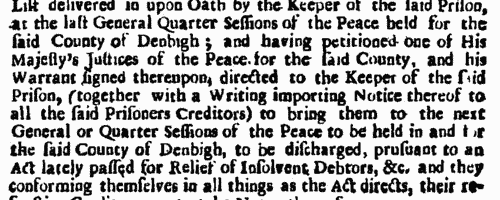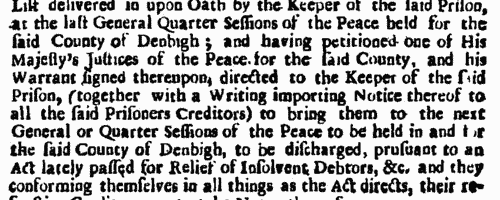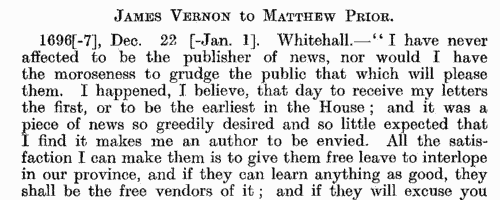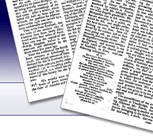Our indexes include entries for the spelling smith. In the period you have requested, we have the following 11,865 records (displaying 951 to 960):
Prisoners for Debt in Durham
(1720)
Notices by persons imprisoned for debt in Chester, Durham, Exeter, Halton, Lancaster, Oxford, Richmond, Ruthin, Southampton, Whitechapel and Worcester, (5876), 9-12 August 1720, of their intention to apply for discharge, pursuant to the Act for the Relief of Insolvent Debtors. The notices give full name, previous residence, and occupation. | Sample scan, click to enlarge

|
Prisoners for Debt in Lancaster
(1720)
Notices by persons imprisoned for debt in Chester, Durham, Exeter, Halton, Lancaster, Oxford, Richmond, Ruthin, Southampton, Whitechapel and Worcester, (5876), 9-12 August 1720, of their intention to apply for discharge, pursuant to the Act for the Relief of Insolvent Debtors. The notices give full name, previous residence, and occupation. | Sample scan, click to enlarge

|
Wigan Householders: Hallgate
(1720)
The poor rate assessment for Wigan is arranged by the seven divisions of the town - Hallgate, Market Street, Millgate, Scholes, Standishgate, Wallgate and Woodhouses - with an appendix of occupiers of lands. Full names are usually given, occasionally with occupation. | Sample scan, click to enlarge

|
Wigan Householders: Scholes
(1720)
The poor rate assessment for Wigan is arranged by the seven divisions of the town - Hallgate, Market Street, Millgate, Scholes, Standishgate, Wallgate and Woodhouses - with an appendix of occupiers of lands. Full names are usually given, occasionally with occupation. | Sample scan, click to enlarge

|
Correspondence of Matthew Prior
(1685-1721)
Matthew Prior was secretary to the British embassy and minister ad interim at The Hague 1693 to 1697, secretary to the embassy at the Congress of Ryswick in 1697, and secretary to the embassy and minister ad interim at Paris 1698 to 1699. His papers survived among the archives of the Marquis of Bath at Longleat, and were edited for the Historical Manuscripts Commission by J. J. Cartwright, A. Maxwell-Lyte and J. M. Rigg, and published in 1909. The volume concludes with a journal and memoirs relating to the Treaty of Ryswick. Most of the correspondence selected deals with the Anglo-Dutch and Anglo-French diplomacy of the period. | Sample scan, click to enlarge

|
 Apprentices registered at Bedford
(1719-1721) Apprentices registered at Bedford
(1719-1721)
Apprenticeship indentures and clerks' articles were subject to a 6d or 12d per pound stamp duty: the registers of the payments usually give the master's trade, address, and occupation, and the apprentice's father's name and address, as well as details of the date and length of the apprenticeship. There are central registers for collections of the stamp duty in London, as well as returns from collectors in the provinces. These collectors generally received duty just from their own county, but sometimes from further afield. Because of the delay before some collectors made their returns, this register includes indentures and articles from as early as 1718. (The sample entry shown on this scan is taken from a Norfolk return) | Sample scan, click to enlarge

|
 Apprentices registered at Bridgwater in Somerset
(1719-1721) Apprentices registered at Bridgwater in Somerset
(1719-1721)
Apprenticeship indentures and clerks' articles were subject to a 6d or 12d per pound stamp duty: the registers of the payments usually give the master's trade, address, and occupation, and the apprentice's father's name and address, as well as details of the date and length of the apprenticeship. There are central registers for collections of the stamp duty in London, as well as returns from collectors in the provinces. These collectors generally received duty just from their own county, but sometimes from further afield. Because of the delay before some collectors made their returns, this register includes indentures and articles from as early as 1718. (The sample entry shown on this scan is taken from a Norfolk return) | Sample scan, click to enlarge

|
 Apprentices registered at Cambridge
(1719-1721) Apprentices registered at Cambridge
(1719-1721)
Apprenticeship indentures and clerks' articles were subject to a 6d or 12d per pound stamp duty: the registers of the payments usually give the master's trade, address, and occupation, and the apprentice's father's name and address, as well as details of the date and length of the apprenticeship. There are central registers for collections of the stamp duty in London, as well as returns from collectors in the provinces. These collectors generally received duty just from their own county, but sometimes from further afield. Because of the delay before some collectors made their returns, this register includes indentures and articles from as early as 1718. (The sample entry shown on this scan is taken from a Norfolk return) | Sample scan, click to enlarge

|
 Apprentices registered at Chester
(1719-1721) Apprentices registered at Chester
(1719-1721)
Apprenticeship indentures and clerks' articles were subject to a 6d or 12d per pound stamp duty: the registers of the payments usually give the master's trade, address, and occupation, and the apprentice's father's name and address, as well as details of the date and length of the apprenticeship. There are central registers for collections of the stamp duty in London, as well as returns from collectors in the provinces. These collectors generally received duty just from their own county, but sometimes from further afield. Because of the delay before some collectors made their returns, this register includes indentures and articles from as early as 1718. (The sample entry shown on this scan is taken from a Norfolk return) | Sample scan, click to enlarge

|
 Apprentices registered at Chichester in Sussex
(1719-1721) Apprentices registered at Chichester in Sussex
(1719-1721)
Apprenticeship indentures and clerks' articles were subject to a 6d or 12d per pound stamp duty: the registers of the payments usually give the master's trade, address, and occupation, and the apprentice's father's name and address, as well as details of the date and length of the apprenticeship. There are central registers for collections of the stamp duty in London, as well as returns from collectors in the provinces. These collectors generally received duty just from their own county, but sometimes from further afield. Because of the delay before some collectors made their returns, this register includes indentures and articles from as early as 1718. (The sample entry shown on this scan is taken from a Norfolk return) | Sample scan, click to enlarge

|
Research your ancestry, family history, genealogy and one-name study by direct access to original records and archives indexed by surname.












